|
|
Support | Resource Center | PhotoImpact Pro
Creating a Video CD Slideshow with Photo Explorer
(Part 1 - Part
2)
Photo Explorer is more than just an image browser. It
also has the capability to combine your favorite photos and images into
a multimedia slide show, complete with eye-catching transitions and text
effects. You can even add your own audio commentary or musical accompaniment
to a slide show. With Photo Explorer’s slide show creator, it’s
easy to arrange a great looking slide show for viewing on either a computer
or TV. No matter what the details of your slide show, the procedure for
creating it is essentially the same. Just follow these steps and your
slide show will be showing on a TV or computer screen in no time.
Step 1: Build a Slide Show
The first step in creating a slide show is to assemble your selection
of images and put them into the proper sequence. This is much easier to
do if you first gather all the images together into a single folder on
your hard drive.
- To get started, open Photo Explorer and use the familiar tree-type
folder listing to locate and select c:\Program
Files\Nova Development\Photo Impact Pro\Tutorial Images\ Creating
a Video SlideShow. When you select the appropriate folder,
thumbnails of your images appear on the right side of the window.
- Now you are ready to begin constructing a slide show. Choose
Slideshow from the Tools
menu. The slide show panel appears at the bottom of the Photo
Explorer window.
|
|
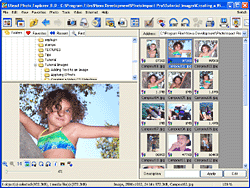
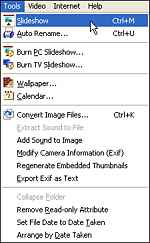
|
- Now comes the fun part: Drag an image from the thumbnail list
down into the slide show panel. It appears there inside of a small
frame, called a slide. Continue to drag images to the slide show
panel until you have assembled a row of slides. You can drag images
to the slide show panel one at a time, or you can select several
images and drag the selected group into the slide show. Don’t
worry if the slides are not arranged perfectly at first; you can
rearrange them later.
- Drag the slide icons left or right as needed to rearrange the
slide sequence. Remember that the slides will be displayed, one
at a time, in order, from left to right. If you find a slide in
the slide show panel that you want to remove, just click that
slide and press Delete. It disappears from the slide show panel.
|
|

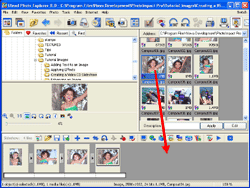
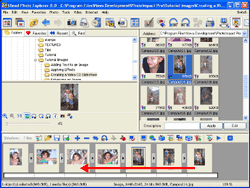
|
Step 2: Customize the Slides
in a Slide Show
After you assemble the images for your slide show, you can customize the
presentation by adding a caption or description to each image. You can
also add an audio commentary that will play back while the image is on
screen.
- Select a slide in the slide show panel, and then click the Slide
Options button to open the Slide Options dialog box.
- Type a short caption in the Description
box. For example, you might type Our
favorite vacation spot. This text will be displayed in
the border of the screen around your image during the slideshow.
You will be able to specify the location and appearance of this
text a little later.
- To add a voice narration to the slide, click the Enable
sound annotation check box. If you have pre-recorded the
narration, select the Select sound
file option and type the file name of the sound file into
the File name box. If you don’t
already have a sound file to play with this slide, you can quickly
record a voice-over description if you have a microphone plugged
into your computer. To record your narration, select Recorded
sound and then click the Record
button (red circle), and begin speaking into the microphone. When
you are finished, click the Stop
button (black square).
- Slide shows have a default duration setting that controls how
long each slide remains visible on the screen. However, you can
override that default setting for individual slides. To set the
slide duration for the current image to five seconds, click Custom
and type 5 in the box to the right. Alternatively, if you have
chosen to include an audio annotation for this slide, you can
select Same as sound annotation
to have the slide remain on the screen as long as the selected
audio clip.
- Click OK to apply your customization
to the current slide. Repeat these steps for any other slides
that need optional settings.
|
|
 |
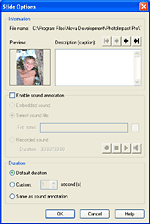
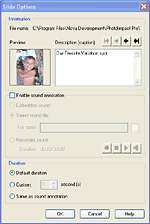

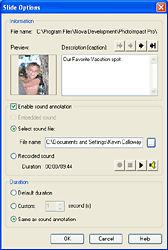
|
(Part
1 - Part 2)
Back
to PhotoImpact Pro Tutorials
|







